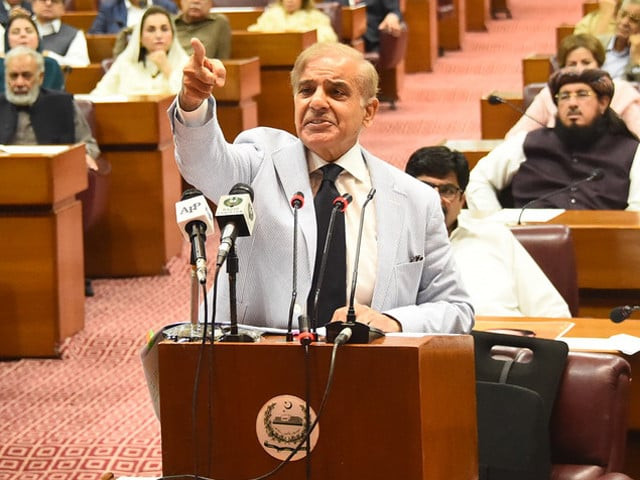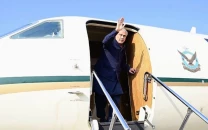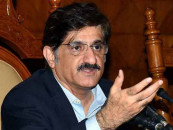Govt jacks up power tariff by Rs4.8 per unit, keeps fuel prices unchanged
OGRA had recommended hiking petroleum prices by up to Rs51 per litre

Prime Minister Shehbaz Sharif on Friday turned down proposed increase in fuel prices up to Rs51 per litre effective from April 16, 2022.
Oil and Gas Regulatory Authority (Ogra) had proposed increase in price of diesel by Rs51.32 per litre (35.7%), petrol Rs21.30 per litre (14.2%), kerosene oil Rs36.03 per litre (28.7%) and light diesel oil (LDO) Rs38.89 per litre (39.9%).
However, the premier had turned down proposed increase in oil prices that would put an additional burden of around Rs30 billion on government exchequer.
The National Electric Power Regulatory Authority (Nepra) on the other hand raised the power tariff by Rs4.8 per unit on account of fuel adjustment for the month of February.
The CPPA-G had requested the power regulator to allow an increase of Rs4.9441 per unit to burden the power consumers with an impact of Rs38.4 billion.
The power regulator conducted a public hearing on March 31, 2022. However, it approved the increase of Rs4.8530 per unit to put an additional burden of around Rs37.7 billion on power consumers.
The power distribution companies will charge fuel cost adjustment (FCA) of February 2022 in the billing month of April 2022 to all consumer categories of XWDISCOs, except lifeline consumers.
Read more: NEPRA raises power tariff by Rs4.8 per unit
Following the prime minister's decision to not increase the fuel prices, the government would have to pay this amount to oil firms on account of price differential claims (PDCs).
An amount of Rs30 billion is already due on account of price differential claims due to keeping oil prices unchanged from April 1, 2022.
The government will be paying price of Rs60 billion to oil companies due to maintaining existing oil prices for month of April.
The government has maintained existing price of diesel at Rs144.15 per litre, petrol Rs149.86 per litre, kerosene oil Rs125.56 per litre and light diesel oil (LDO) Rs118.31 per litre.
PML-N leader Shahid Khaqan Abbai also confirmed the development, saying that PM Shehbaz has decided to keep the petroleum prices unchanged.
He said the previous PTI-led government made a wrong decision to provide subsidy on petroleum products which he said will damage the country’s economy.
Read more: PM to pass on burden of POL price hike to next govt
“They misled the masses and [reduced petroleum] prices for cheap publicity,” he observed while addressing a press conference in Islamabad flanked by former finance minister Miftah Ismail.
عالمی ادارے جن سے ہم ٹیکس لیتے ہیں IMF اور ہمارا ٹیکس کا نظام جس میں ہمارا سیلز ٹیکس ہوتا ہےجو پیٹرول کی قیمت بتائی ہےاس میں یہ ٹیکس شامل نہیں ہے اگر یہ ٹیکس شامل کریں تو اوگرا کے مطابق پیٹرول 235 روپےاور ڈیزل 264 کا ہونا چاہیے.شوکت ترین نے IMFسےجو وعدےکیےتھے یہ رقم اسکے مطابق ہے pic.twitter.com/YPzHZhRcHX
— PML(N) (@pmln_org) April 15, 2022
“We have been working on this matter for the past three days and today’s Ogra summary recommended to increase petrol price by Rs21 and diesel by Rs51 per litre but the prime minister did not accept.”
Abbasi said the government will have to provide subsidy of 72 billion rupees per month to maintain the current fuel prices and added that it was not possible to bear the burden of subsidies given the condition of the economy and rising international prices of fuel.
Former PM Imran Khan had announced a reduction of Rs10 per litre in the petroleum prices and that the new rates would remain in place till the FY-23 budget.
However, this decision of keeping oil prices unchanged had no legal cover as the previous government had not approved it.
If the current government decides to keep oil prices unchanged from April 15-30, then it will have to give another Rs30 billion subsidy.
Officials said that impact of rupee depreciation against dollar had also resulted in increase in oil prices by Rs5.54 per litre or 3.03 per cent.
Average rate of dollar had jumped from Rs182.15 to Rs188.15.
Also read: Diesel set to rise above Rs200
High speed diesel (HSD) is mainly used in transport and agriculture sectors. At present, the sowing season was going on and therefore its consumption will be higher that would put an additional burden of subsidy or price differential claims on the government.
Petrol is used in motorbikes and cars across the country.
Punjab province had already shifted on imported gas in CNG stations for last several years and therefore customers living in this province will be facing major dint if petrol price go up.
Kerosene oil is used in those remote areas of the country where LPG was not available for cooking. The largest consumer of kerosene oil is Pakistan army in remote areas like northern part of the country.
Light diesel oil (LDO) is used in industry.
The circular debt situation in oil and gas sectors had already been worsening and accumulation of subsidy or price differential claims would lead to increase circular debt in coming days.
Petroleum Division had moved a summary to ECC on April 1, 2022 that additional Rs55 billion may be allocated through supplementary grant for the disbursement of PDC to OMCs/Refineries for the month of April, 2022.
The matter has not yet been considered by ECC.
The international energy markets remain volatile and the premiums on MS and HSD remain high. The liquidity of OMCs / refineries is, therefore, under stress. Subsidised prices of petroleum products add to this stress because the full cost recovery is made only when PDC claims are processed after a lag of almost a month.
If the energy markets remain in their present situation, the estimated amount of PDC for the period between 16th April, 2022 to 30th June, 2022 would be Rs136 billion.
The demand of MS and HSD in the country remains very high. This high demand is not only making the petroleum market vulnerable to supply disruptions and placing a very heavy burden on the liquidity in the sector, but is also increasing the import bill to a very high level.



















COMMENTS
Comments are moderated and generally will be posted if they are on-topic and not abusive.
For more information, please see our Comments FAQ